
1977-2022: The Story of the Firsts
It is first and foremost a story that starts with a visionary. In 1976, François Chalain, who had just joined the Beneteau group, suggested to the company’s young president Annette Roux that they buy the moulds of Impensable, winner of the 1973 Half Ton Cup. The Vendée boatyard switched from wood to polyester in the 1970s, but it only produced recreational fishing boats. Annette Roux readily admits: “Nobody was really waiting for us to go there.”
François Chalain won her over, and, with the designer André Mauric, he modified the keel of Impensable, lengthened the coachroof and gave it a more comfortable fit out. They had just found the right balance between racing and cruising.
“François had the vision and, above all, saw the need to bring all the elements of a boat together. He paved the way”, recalls Jean-François LAIR, current director of the Beneteau brand, when talking about the designer who sadly died in 2007.
Called First, the 30 footer was shown in 1977 at the Paris Boat Show. It remained the yard’s catalogue for five years and 824 boats were sold.
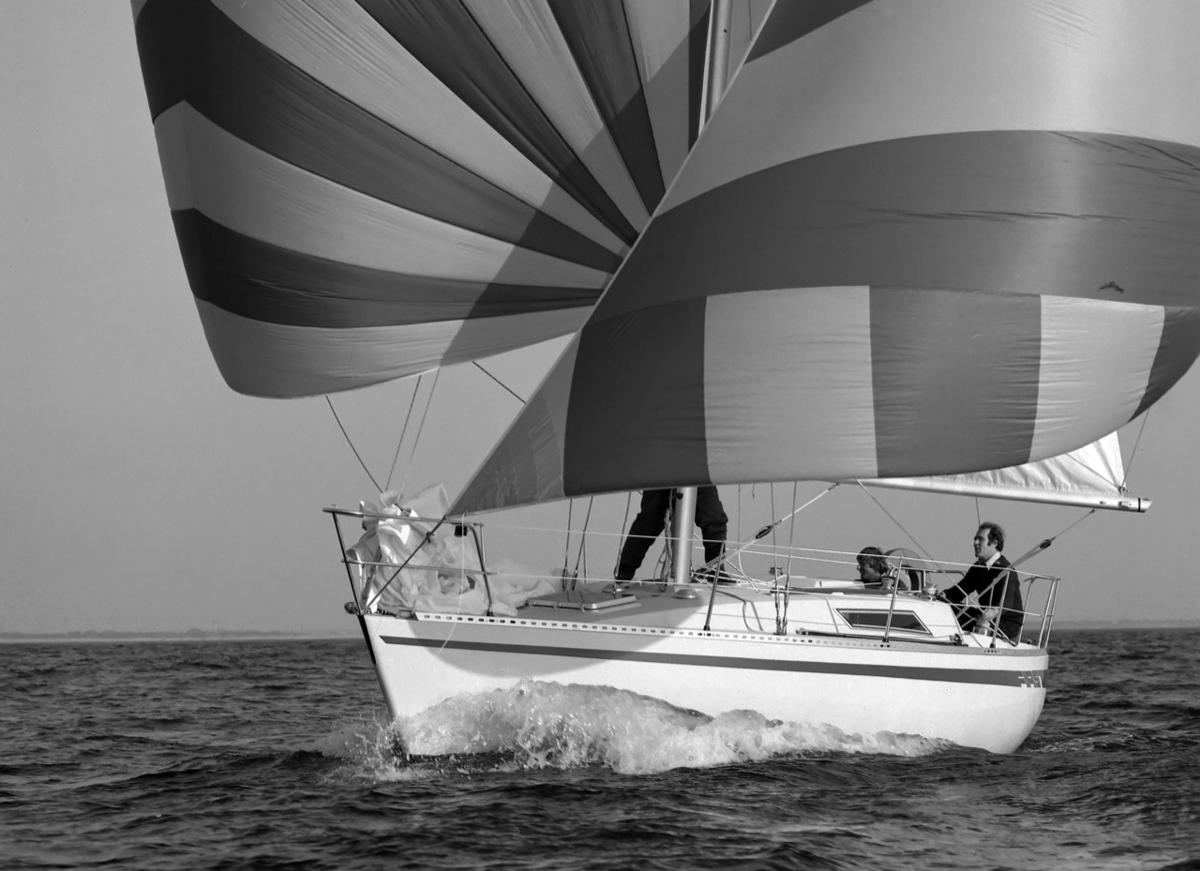
Since then, it has been followed by 70 different First models, from 14 to 53 feet, the latest being the First 36, a new design by Samuel Manuard launched this year. Also in the wings is the First 44 which will be world premiered at the Cannes Yachting Festival in September.
Through the popular Class 8 from 1982 and then three generations of Figaro (1990, 2003, 2019), the brand has a strong one-design offering. But in saying that it is worth remembering that the yard has always been skilful at making the most of the current rules. The most successful period was undoubtedly that of the IOR rule in the 1980s, a line which brought prototypes – the First Evolution – and production boats together.
In the 2000s, the emergence of the IMS and especially the IRC gave rise to some particularly successful production boats that could compete with the best prototypes. This is how First National, a First 40.7, won the Sydney Hobart, all classes combined, in 2003 and Gery Trentesaux won the Fastnet Race (in IRC 0) at the helm of his First 44.7 Courrier du Coeur in 2007. Even though Beneteau, the world leader in leisure craft, has made the most of its substantial international network, the history of the Firsts shows what an important role the relationship between industry and craftsmanship plays.
Now that the sales of performance cruisers have decreased, the yard has chosen carefully measured production lines.
“In 2015, Madame Roux wanted to relaunch the First range,” says Jean-François LAIR. “So, we joined Seascape in 2018 for their range of sportboats which was an accelerator. And there in Slovenia we produced the First 36. And for the First 44, we have returned to a dedicated workshop in Poiré-sur-Vie (Vendée).This is the right method, and the experience of the First 36 shows that the market is out there.”
The Golden Age of IOR Racing
Following the success of the First 30, launched in 1977, within three years Beneteau had built a line of six First sailing yachts, ranging from 18 to 35 feet. The yard was running at full capacity, producing over 1,000 boats in 1980, and it rose to become the leader of a fast-expanding recreational sailing industry. In 1982, Bertrand d’Enquin joined Beneteau to look after their American clients, and noticed that Annette Roux, the group’s president and François Chalain, the father of the First line, “continued their efforts. They understood that Beneteau needed to win well-known races and expand their reach beyond France’s borders, to sustain this industrial success story.”
The boatyard called on the Argentinian architect of the Swan boats German Frers to build the subsequent large models, who designed the iconic First 42 and 456. In 1979, they turned to Jean Berret for the racing approach. He had just designed the excellent First 35, for a small production run of half tonners. The First earned itself a great reputation in regatta racing with prototypes wordplay in their names (Alonzo Bistro, Crac Boum Ut, etc.), built at Hervé’s yard in La Rochelle and then at his brother’s yard, Technicoque. 13 First 30 Evolution sailing yachts were produced to race in the IOR Championships (International Offshore Rule), the old rating created towards the end of the 1960s.
They were built in a workshop fitted out by Beneteau in Saint-Hilaire-de-Riez, beside the joinery. “We were already using vacuum construction methods at the time. We worked with a small team of ten of the best, as a rule. The boats were built upside down, on a model or a male mould,” Jean-Michel Crochet recalls, the First preparateur at the time.
The Legendary Rubis
Working alongside François Chalain was Eric Ingouf, a familiar face on the Ton Cup scene. He did a considerable amount of work on the deck plans and also on compliance with the distorted IOR shapes. The rating rule increased the number of measurement points along the hull. So, using the perfect casing, the architect created bumps to maximise the rating measurement points.
“This is also why we used a special team of painters, from the East, who were experts in cambering hulls, so as not to alter the shape and the measurements”, said Jean-Michel Crochet.
It was a success, since First Lady, named after Annette Roux, came second in the Half Ton Cup in 1980.
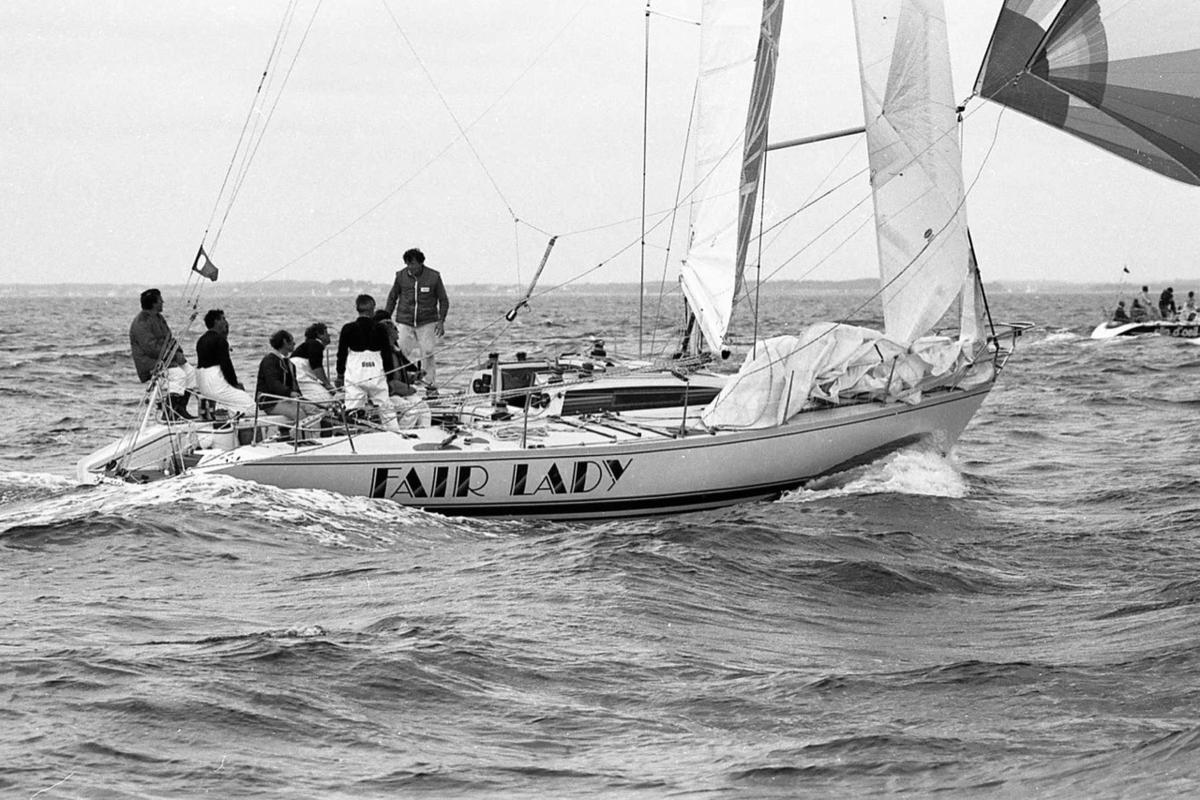
The following year was a good one with the legendary Danish skipper Paul Elvstrøm, four times winner of the Olympic Games, winning the trophy on King One, another First Evolution. With these wins, the boatyard gained legitimacy and launched the First 30 E (on another hull), with 420 boats produced in three years!
Three years later the same thing happened with the one tonners. For the first time, Beneteau brought the best of French architecture together. The small production of First 40 Evolution sailing yachts was designed by Berret-Fauroux-Finot. The prototypes were called Phoenix (Harold Cudmore), Fair Lady (Eric Duchemin) and Coyote (Bruno Troublé) and monopolised the podiums in the English Channel and across the Atlantic. They gave rise to the great First 405 class, with over 200 boats built, for what was considered a big boat at the time.
The high point of the IOR decade was the building of Rubis in 1989. The two tonner owned by the watchmaker Corum was the result of the teamwork of Philippe Briand, Philippe Pallu de la Barrière and Luc Gellusseau, who had already worked on French Kiss in the America’s Cup 1987. The sailing yacht boasted a distillation of new features, with an innovative deck plan, two side coachroofs acting as spinnaker snuffers, a set of rope clutches midships, and crew members strapped to the hiking bench for offshore races. It won the 1991 Admiral’s Cup, alongside Corum Saphir and Corum Diamant, at the time the world championship of offshore racing.
A Wave of First Class 8 Yachts
How do you make a boat that is at once beautiful, comfortable, wins regattas and produced at the right price? This is the challenging task that the brains at Beneteau, president Annette Roux, managing director François Chalain, and his right-hand man Eric Ingouf, were confronted with continuously.
“You must appreciate that there was no Oceanis at the time. The market was not segmented. So, a First was a boat that had to do everything,” explains Jean-François LAIR, now the Beneteau brand director.
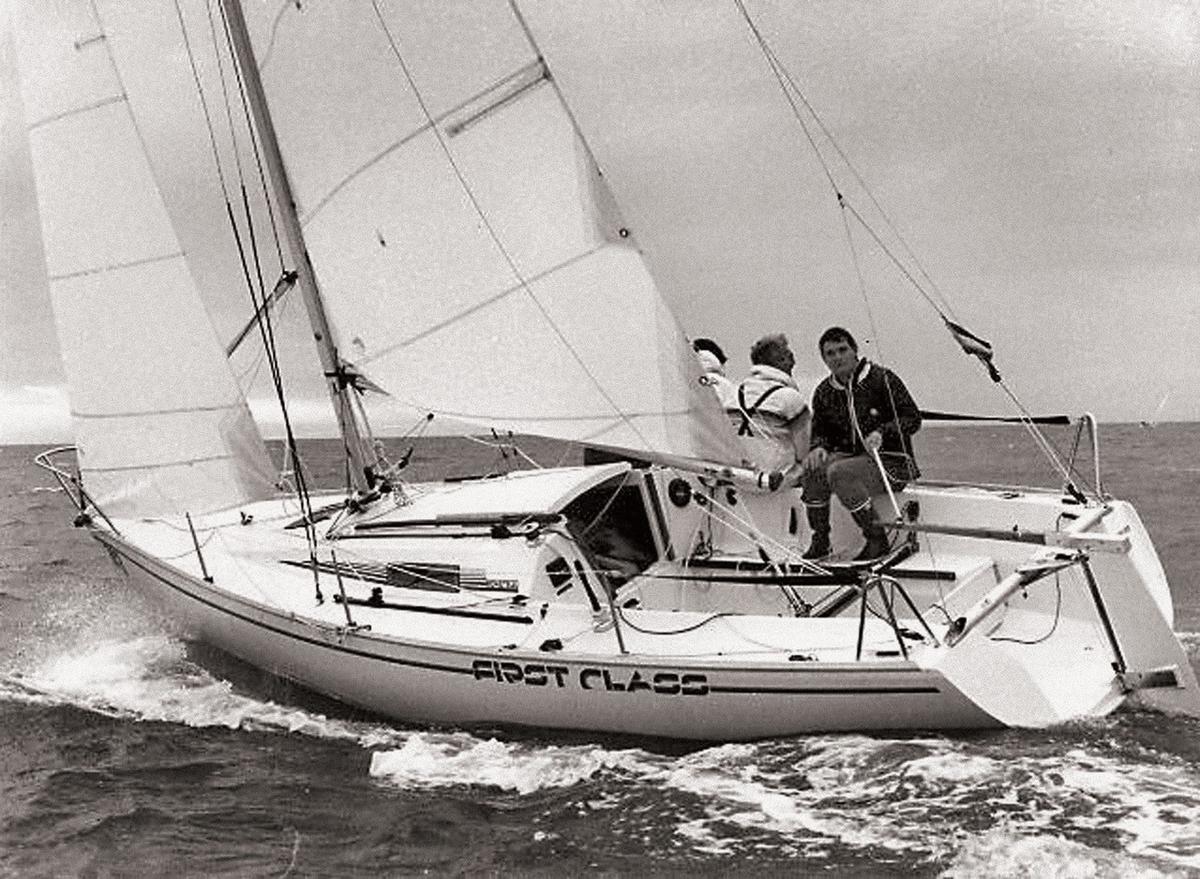
The IOR prototypes were highly-regarded, but their sophistication became ever more expensive and Annette Roux repeated over and over to her staff that “a Beneteau must always be good value for money.” “The First Class was a brilliant way of emerging from a compromise that was increasingly hard to keep” Out went the wood inside, the linings and the other heavy and expensive claddings. Out went the IOR and its bumpy hulls. It was time to make way for simplicity and surfing.
Two Architects
So, who would design this new one-design? As for the First Class 8, and a few years later the Figaro 1, two brains were better than one and the one design produced in 1982 had two designers: Jean-Marie Finot and Jacques Fauroux. The former earned a name for himself with the one tonner Révolution for his taste for large sterns. The latter was the quarter tonner world champion.
They created a one design that was low on the water, had a very smooth hull, ran well at all speeds, and had a fractional rig and a good sail area. The boat also made use of the lifting keel system again, invented by Finot and Beneteau on the First 22 in 1978. The Class 8 weighed 1.3 metric tonnes but proved to be much easier to trail by road than a Surprise, the big competitor at the time. With a beam of 2.5 metres, its size was suitable for road transport, unlike the international J24 one design, which never really took off in France. And so what if the toerail cut into the thighs of generations of crews, and if the unbalanced rudder, articulated on an aluminium beam, made the tiller heavy, The Class 8 quickly became a social sensation.
”Clubs were needed, but also the strength of the Beneteau network, already well established internationally,” recalls Bertrand d’Enquin, in charge of American customers. “All our agents worldwide bought two or three, and sometimes small fleets.” The result was that within two years, over 300 boats were produced, “more than the number of quarter tonner prototypes ever built,” said Jean-Marie Finot.
The Regatta Racing Elite
Very soon a class association was established, a partner found with CG Mer the financing body, and a championship circuit planned. “We transported the fleets by truck to the regatta sites, 30 boats at a time, recalls Jean-Michel Crochet the preparateur. Frequently, I had to put up with doing the preparation alone, but it was really simple, and the boats were raceable within a day.”
The deck hardware was a little scanty when the Class 8 was launched, so the crew had to do some tweaking. The boatyard introduced the idea of a set of rope clutches midships just above the companionway on its new productions, allowing the crew to manage lines without switching their position when leaning out. Since its simplicity was refreshingly new when it was launched, the Class 8 lasted a good ten years and appealed to the regatta racing elite. The efforts of budding racers were often in vain, leaving the podiums to Bertand Pacé, Pierre Mas, Franck Cammas, Bernard Mallaret, Philippe Presti, Bruno Jourdren and Vincent Riou.
“I saw championships in which 80 boats lined up for the start. This happened all over Europe and the level was very high,” recalls Bertrand d’Enquin. The peak was in 1992 at Cap d’Agde with over 100 Class 8 sailing yachts! It mattered little that the one design did not become an international class (it would have had to have been built under licence abroad). Production of the First Class 8 ceased in 1993. 965 boats were built. The first Beneteau one-design gave rise to a small family with the Class 7, Class 10, Class 12 and Class Europe, admittedly with a small distribution, and prepared the boatyard for the boats to come.
The Legendary S5 and .7
In the mid-1980s, Beneteau realised that they had to segment their offer. François Chalain, launched the first Océanis 350 with the architect Philippe Briand, in 1986, a distinctive cruiser of a new kind.
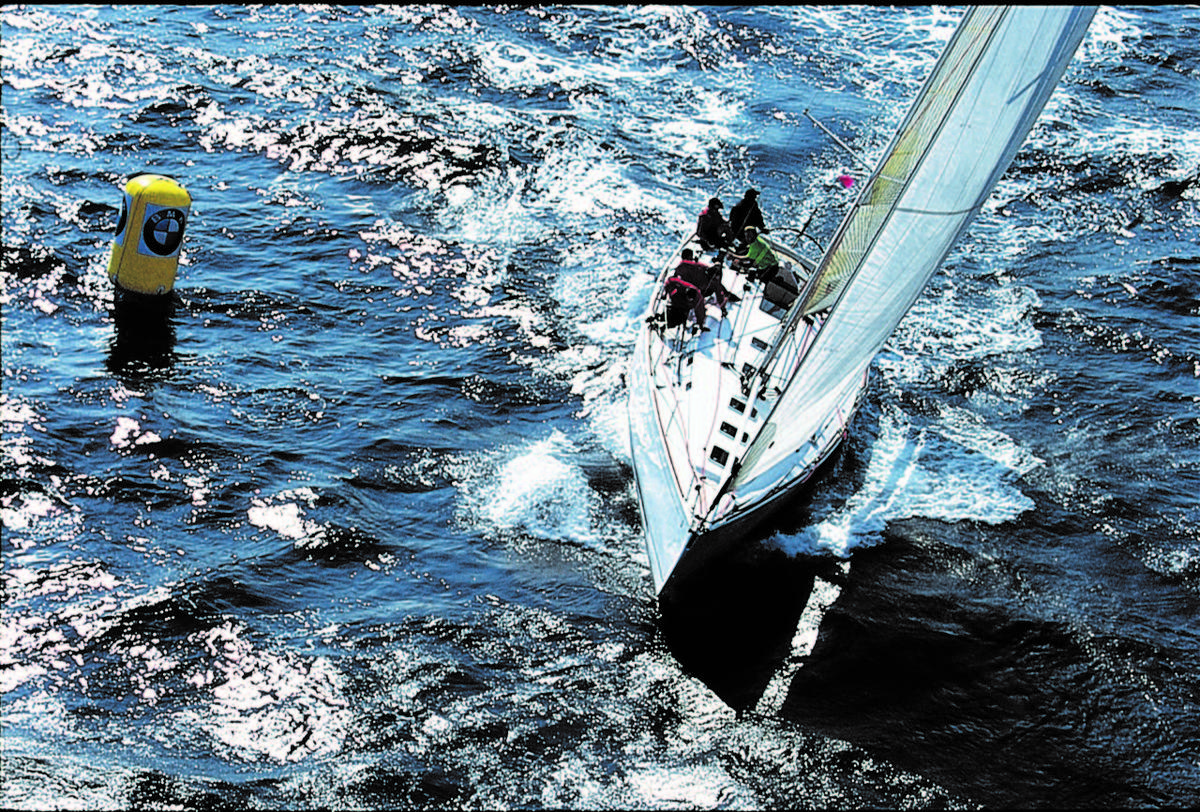
This gave free rein to the First sailing yachts, but they had to be repositioned and made more radical.
Beneteau started to look for an interior designer. François Chalain asked Philippe Starck’s brother, who was a journalist at France 3 (TV channel) and who he met by chance during a report he was filming at the boatyard. “I don’t suppose that your brother has time to consider our boat ideas, does he?” “Think again, Philippe is mad about sailing and much more open than you would think”
35s5: the Triumph of Design
A meeting with the star of international design, was soon planned and it gave birth to one of the most disruptive boats in the history of sailing: the First 35s5. Jean Berret, who designed the hull, remembers “Beneteau took a big risk, since the Starck design cost a lot more and challenged the boatyard’s routines. He brought his style and his ideas, and I had to be resourceful to make it all happen.”
Carbon tiller, portholes extending over the coachroof angle, with an integrated handrail, shiny mahogany interior, white upholstery, forged brushed aluminium table stand, etc. Suffice it to say that the First 35s5 did not pass unnoticed and disrupted customers used to a classic look. “It was the talk of the Boat Show in 1987, when it was launched. Everyone thought they were mad!” recalls Jean-François LAIR, the current director of the Beneteau brand. “It was the first time that a designer from outside of the boating industry contributed to the design of a boat.”
Despite only being marketed for a fairly brief period of four years, the sales figures were satisfactory. The look was applied to the whole line which ranged from 32 to 53 feet; a sign that leisure sailing was changing and moving upmarket.
The Versatility of the 31.7
Ten years later, the s5, followed by the s7 were replaced by a new class. For the new line’s smallest boat, Beneteau continued to place its trust in Jean-Marie Finot and Pascal Conq, who designed the First 31.7 – “perhaps the best of all of them”, according to the Jean-Michel Crochet, the preparateur for all the Firsts at the time. “The 31.7 was versatile, had the Figaro 1 hull, and a well-designed interior. “An amazingly easy boat that everyone could sail. Some customers never wanted to change!”
It was of little importance that the 31.7 was not highly optimised for IRC and never won the Spi Ouest-France “even when there were 30 boats competing in IRC4 against the legendary half tonner Brittany Drizzle”, stresses Christophe Cantin, currently the owner association’s president. About 1,200 of these faultless boats left the production lines, making it the 30-foot performance cruiser with the highest distribution ever!
The 31.7 continues to race regattas everywhere – 16 of them raced among the one-designs in the last Spi Ouest-France – and still appeal to demanding owners, such as Jean-Yves Le Déroff and Philippe Delhumeau.
The 40.7 Won Over the Chinese
At the same time as the “little” 31.7 was launched, so was the 40.7, which also had a very fine career, with nearly 700 boats sold. This plan was a timeless classic designed by Bruce Farr and it won everything from the day it was launched (Commodore’s Cup and Copa del Rey in 1997) and rose to the top of the overall ranking of the Sydney Hobart in 2003.
When the Shenzhen province created the China Cup, in 2007, to rival with Qindgao, which had been awarded the Olympic Games of 2008, Beneteau produced a fleet of 10 boats, and then, following the concept’s success, 20 more the following year. The 40.7 became China’s one design. As new to offshore racing as they were ambitious, “the Chinese wanted to create an event that would outdo the America’s Cup!” explains Yves Mandin, who manages the event for Beneteau. And to continue: “we told them that it would still take quite a long time! But the fact remains that all the China Cups competed in since 2007 have all been very good events showing great sportsmanship and won by highly regarded skippers.”
One Figaro Can Conceal Another
Towards the end of the 1980s, the Solitaire du Figaro was still raced on half tonners, which had become marvels of technology, but whose steep cost prevented equal opportunity among contenders. The race manager Michel Malinovsky, who had raced in the Course de l’Aurore (the old name for the Solitaire) on a First 30, and Jean-Michel Barrault, cofounder of the race in 1970, approached Beneteau to design a one design that did not require a rating.
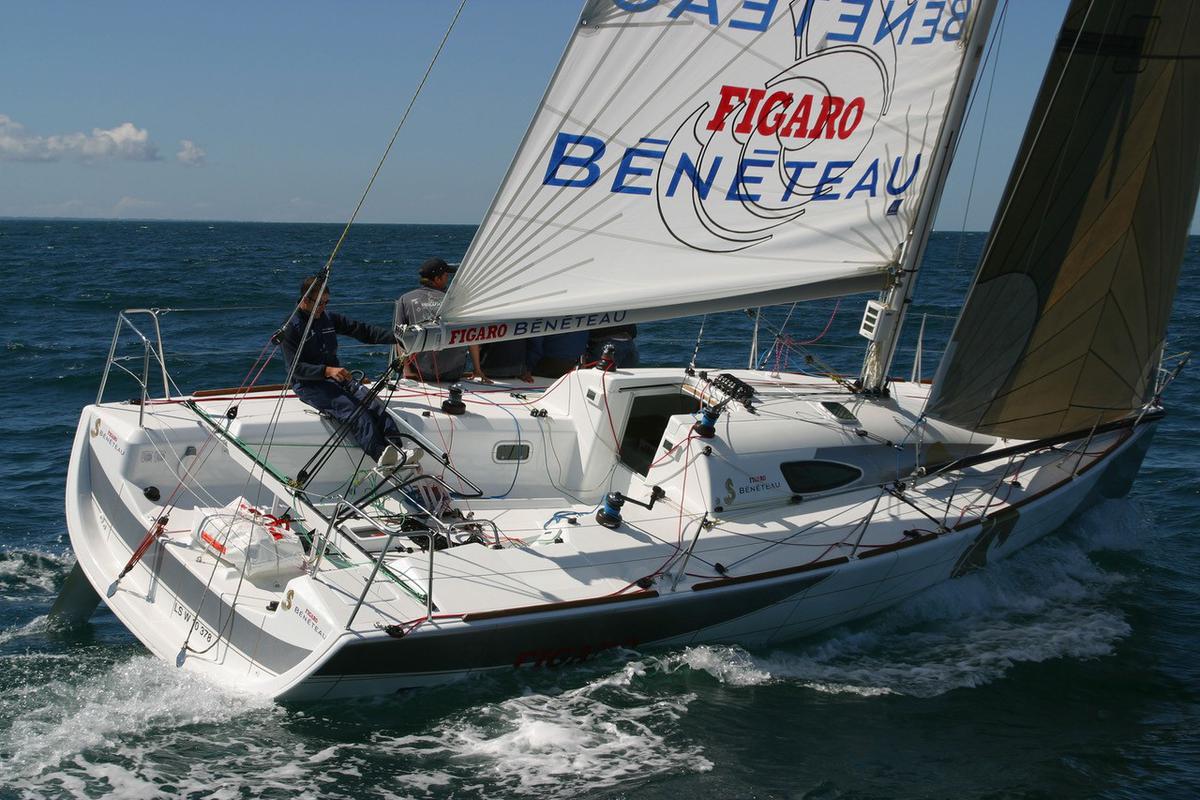
The Finot-Berret duo then launched the First Class Figaro Solo and Laurent Cordelle won the first Solitaire (single-handed race) on board, in 1990, followed by Yves Parlier, and then Michel Desjoyeaux in 1992, who tells us that “In 1989, I won the Elf Skipper selections and I acquired the last half tonner, which was a real McLaren. Three months later, the race shifted to one designs and I gave back the half! I was better off because I had a boat that could race offshore, was more seaworthy with a rather dangerous first 7/8 rig with runners that I liked a lot.”
The boat was well-designed, but the fairly weak mast was replaced by a 9/10 profile with no runners in 1993, which solved the problem. The boatyard kept up their efforts and every summer, between 1990 and 1996, the First 53 F5 was sailed by Eric Ingouf and Jean-Michel Crochet, taking care of race assistance and after-sales service at the same time. “Incredible stories of incredible times. The saloon was often packed and we were at the heart of the race,” recalls Jean-Michel.
A hull Moulded More Than 2,000 Times!
The boat now referred to as the Figaro Solo won over a very captive market with 61 boats produced. But the career of this well-designed hull did not end here. With versions used on the Figaro Challenge (no ballast), on which the Défi des Ports de pêche was raced, on the First 310, on several Oceanis cruisers and especially the First 31.7, it was moulded more than 2,000 times in the Beneteau workshops, without the owners necessarily being aware that they were taking a little bit of the Figaro with them!
In the early 2000s, the Finot-Berret plan had aged quite a bit, so the boatyard began to think of a new design. Finot remained a firm favourite, but the class selection committee led by Gildas Morvan chose the Lombard studio, which had proved that it could be counted on in the Imoca class. And that is how the second Figaro Beneteau, emerged in 2003, with an extra metre in length. Pascal Bidégorry played a role in the development of this elegant one design, which took a big technical step forward: infused sandwich hull, electric filling of ballasts, carbon mast.
Most importantly, the Figaro Beneteau 2 proved to be much better at staying its course than its predecessor. The skippers could sleep under the spinnaker, the boat’s nose rarely ever dug in.
“The Figaro 2 capitalised on the strengths of the one design features of the Figaro 1. Everything was professionalized to create a solution that still makes sense now”, recalls Michel Desjoyeaux, a member of the very select club of triple Solitaire winners.
The Figaro 3 “Opening Up the Playing Field”
With the Figaro 2, the level of the circuit improved. Training centres trained cohorts of skippers, who made the Figaro their profession, investing in their boat, written off within four or five years. With 250 days of sailing per season, a Figaro’s log clocked up 12,000 to 14,000 nautical miles every year. When the Figaro 3 stepped into play in 2019, some of the Figaro 2s had sailed the equivalent of seven round the worlds! Needless to say, they are still being snapped up today on the secondhand boat market.
In 2017, VPLP won the competition to take up the torch launched by the Figaro class and the boatyard. The Figaro Beneteau 3 was built in a dedicated workshop in Nantes, in the old Jeanneau Techniques Avancées premises. Foils were introduced, which cause a few development problems the first year. 80 boats were built in scarcely two years.
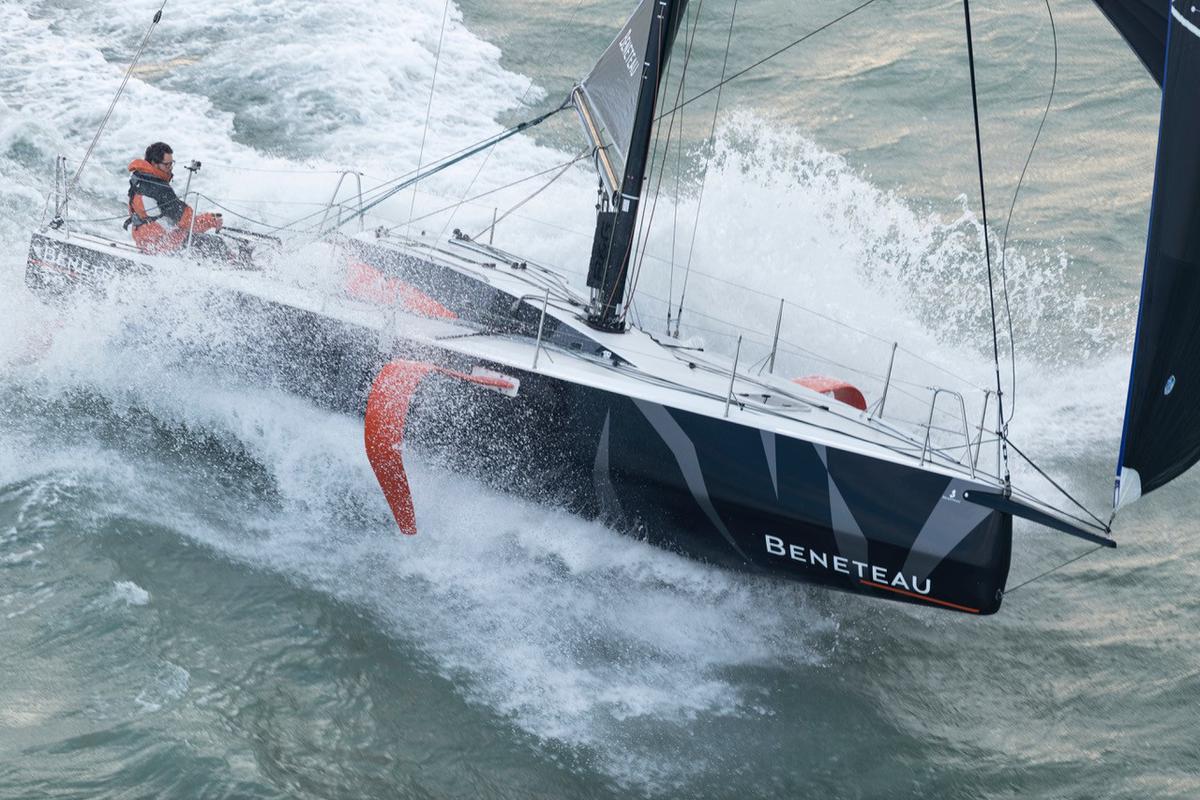
Shorter, much more competitive, and modern, particularly with regard to the sail plan, the Figaro 3 “opened up the playing field”, making options that were formerly random potentially payable and restoring the importance of strategy. It will enable 34 women and men to set sail again from Nantes this year, on Sunday 21 August in an attempt to win the Holy Grail of single-handed racing on equal terms – the Solitaire du Figaro.
Since 2020, the trophy awarded by Beneteau to the first rookie in the race, has been named after Eric Ingouf, the man at Beneteau who developed three generations of Figaro Beneteau.
the Revival of a Line Ranging from 14 to 53 Feet
In the mid-2010s the Firsts lost some of their appeal. The market focused on cruisers and catamarans with the yard’s revenue from the Firsts dropping by 10%. “The boat market experienced the same shift as the car market,” explains Jean-François LAIR, director of the Beneteau brand. “In the 1980s everyone wanted GTIs. Then came station wagons, 4x4s and SUVs.”
After the boom of the 2000s, the 2008 crisis reshuffled the cards. The performance cruiser market saw the arrival of a small production of very specialized sailing yachts based on the IRC rule, against which it is difficult to fight. François Chalain, the real soul of the First brand, died in 2007 and the failure of the First 30 based on a Kouyoumdjian design that was launched in 2010, nearly ended one of the greatest chapters in the history of yachting. But Annette Roux was highly explicit “I want to see a First line again!” she said to Gianguido Girotti, the new product manager whom she appointed in 2015.
Back to Basics
“To relaunch a complete line, the market was actually not big enough for our industrial capacity”, explains Jean-François LAIR. And so, the best option was to buy Seascape in 2017 and make it part of Beneteau’s offering.” The small Slovenian manufacturer made a name for itself in a few years with its 14-to-27-foot sport boats designed by Samuel Manuard. The boats were rebadged First and benefitted from the size and strength of the network, which revived the line and bought time to develop a real product strategy for the larger sizes.
In 2019, the First Yacht 53 was released, designed by Italian architects Roberto Biscontini and Lorenzo Argento, a real break from the regatta boats on the market.
“The First 53 has the “wow factor,” a boat that makes you dream”, stresses Yves Mandin, Director of the BENETEAU Premium Department. “These are boats that meet the expectations of demanding customers. Of the 35 delivered, about ten race quite actively, mainly in the Mediterranean, the others are more in the yachting spirit.”
First 36: The Bridge
But they were missing a connection, a bridging model between the small First and the 53-foot flagship. So, in 2019, studies for a 36-footer with Sam Manuard were launched. Modern lines, relatively light and planing, allowing you to sleep onboard but with a minimalist layout, the First 36 revived the best dual purpose boat line in the history of the yard.
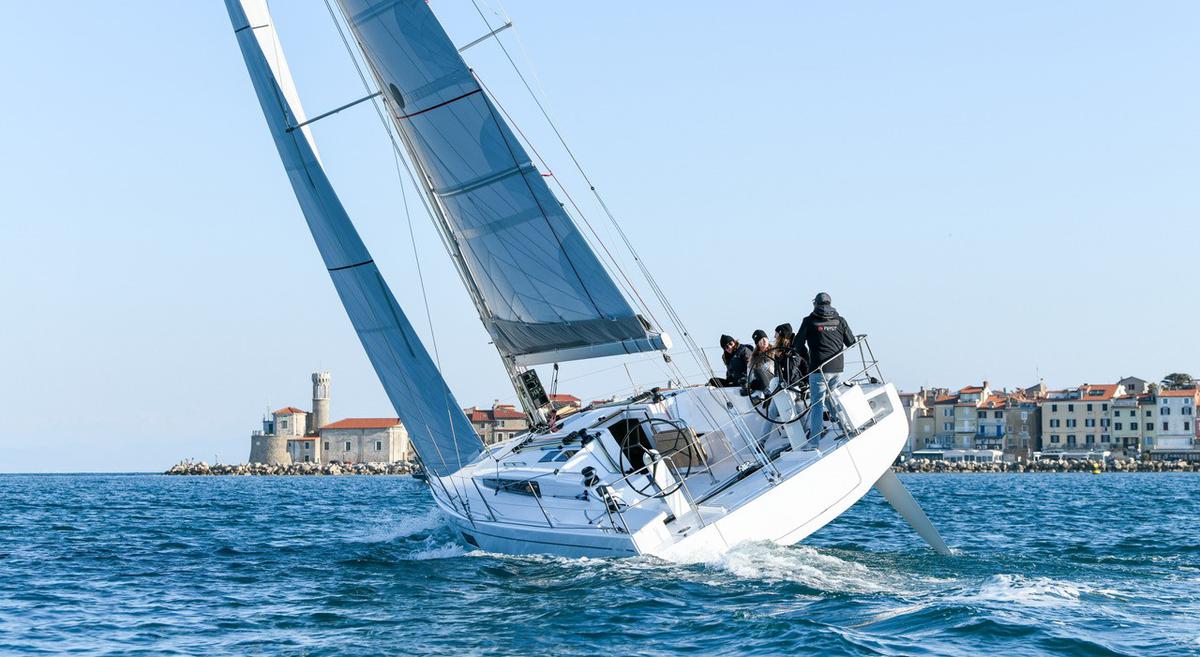
Developed jointly with Seascape in Slovenia, where it is built, it uses technical solutions that would not be possible on a large production line: sandwich bulkheads, infusion, grafting of the structure with re-lamination, the 36-footer is built like a racing sailboat in its own right, but its versatility makes it a very appealing. And the market has responded favourably, because six months after the launch a full two years’ worth of orders has already been placed!
For the First 44, which will have its world premiere in September at the Cannes Yachting Festival (September 6-11), the same reasoning has prevailed, designed by the same architectural duo as the 53-footer, it will be built in a dedicated factory in Poiré-sur-Vie, in Vendée, by a small team of around twenty people. It is a fast-cruising boat more than a regatta racer. It is available in several deck plan versions, with rigging tailored to a range of programmes. As an option owners can choose ballasts that eliminate the need for crew rialto lean out. “We are aiming for around thirty boats a year. 45 feet is the premium size in a market which we have neglected for too long and the expectation is high”, concludes Jean-François LAIR.
45 years on, the story of the First continues…
Published on 02.11.2022